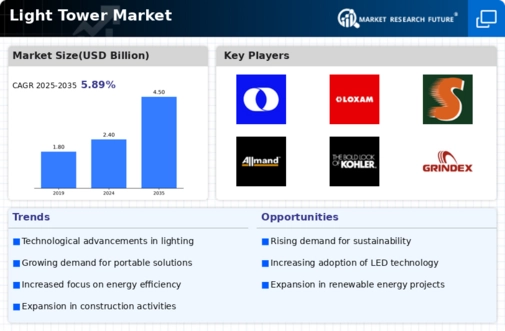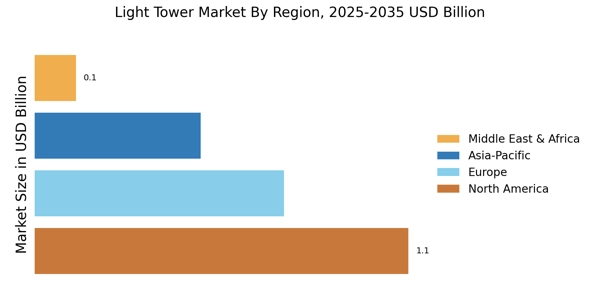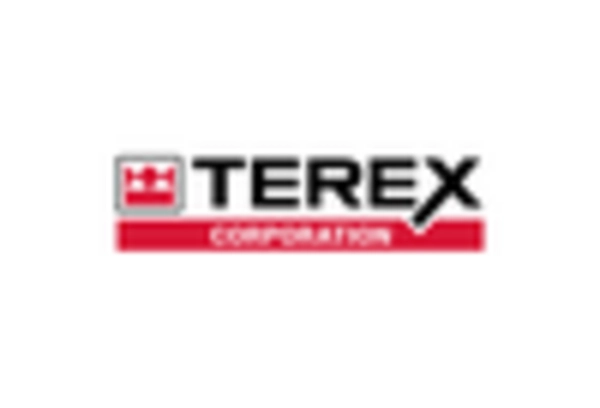Expansion of Events and Outdoor Activities
The Light Tower Market is experiencing growth due to the rising number of outdoor events and activities that require effective lighting solutions. Festivals, concerts, and sporting events often take place during evening hours, necessitating the deployment of light towers to ensure visibility and safety for attendees. In 2025, the events industry is projected to expand, with an increasing number of outdoor gatherings planned worldwide. This trend creates a substantial opportunity for light tower manufacturers and rental companies, as event organizers seek reliable lighting solutions to enhance the experience for participants. The Light Tower Market stands to benefit from this expansion, as the demand for portable and efficient lighting solutions continues to rise.
Rental Market Growth and Cost-Effectiveness
The Light Tower Market is witnessing a shift towards rental solutions, driven by cost-effectiveness and flexibility. Many companies prefer renting light towers rather than purchasing them outright, particularly for short-term projects or events. This trend is expected to grow in 2025, as businesses seek to optimize their operational costs while maintaining access to high-quality lighting equipment. The rental market for light towers is projected to expand, with an increasing number of rental companies offering diverse options to meet varying customer needs. This shift not only enhances the accessibility of light towers but also stimulates competition within the Light Tower Market, encouraging innovation and improved service offerings.
Technological Innovations in Lighting Solutions
Technological advancements play a crucial role in shaping the Light Tower Market. Innovations such as LED technology and solar-powered light towers are gaining traction, offering energy-efficient and sustainable lighting solutions. The integration of smart technologies, including remote monitoring and automated controls, enhances the functionality of light towers, making them more appealing to end-users. In 2025, the market for LED light towers is expected to account for a significant share, driven by their longer lifespan and lower energy consumption compared to traditional lighting options. As these technologies evolve, they are likely to redefine the standards of performance and efficiency within the Light Tower Market, attracting a broader customer base and fostering competitive advantages.
Growing Focus on Safety Regulations and Compliance
The Light Tower Market is significantly influenced by the increasing emphasis on safety regulations across various sectors. Governments and regulatory bodies are implementing stringent guidelines to ensure safe working conditions, particularly in construction and industrial environments. Compliance with these regulations necessitates the use of adequate lighting solutions, such as light towers, to mitigate risks associated with poor visibility. In 2025, it is anticipated that the enforcement of safety standards will drive the demand for light towers, as companies prioritize investments in equipment that meets regulatory requirements. This trend underscores the importance of the Light Tower Market in contributing to workplace safety and operational efficiency, as organizations seek to avoid penalties and enhance their reputation.
Increasing Demand for Construction and Infrastructure Development
The Light Tower Market experiences a notable surge in demand due to the ongoing expansion of construction and infrastructure projects. As urbanization accelerates, the need for reliable lighting solutions at construction sites becomes paramount. In 2025, the construction sector is projected to grow at a compound annual growth rate of approximately 5.5%, driving the need for light towers that enhance safety and visibility. This trend is particularly evident in regions where large-scale infrastructure projects are underway, necessitating the deployment of light towers to ensure operational efficiency during nighttime activities. Consequently, the Light Tower Market is poised to benefit from this increasing demand, as construction companies seek to invest in advanced lighting solutions that comply with safety regulations and improve productivity.

















Leave a Comment